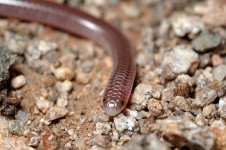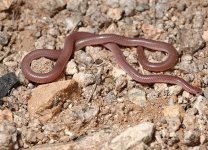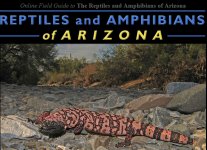| Range: |
 |
| Other Names: |
Western Threadsnake, Trans-Pecos Threadsnake |
| Subspecies: |
Trans-Pecos Blindsnake Leptotyphlops humilis segregus |
| Description: |
A small (up to 389 mm or 15" in total length), relatively thin, pink, gray, or mauve snake that resembles a shiny earthworm. Both the head and tail are rounded and blunt. The head is not distinct from the neck. The eyes are vestigial and appear as dark spots underneath the ocular scales. Unlike most of our snakes the belly scales of this snake are not enlarged. A small spine protrudes from the end of the tail. There are no teeth in the upper jaw and only a few teeth in the lower jaw. |
| Similar Species: |
This snake has only one scale between the oculars on the top of the head distinguishing it from the similar looking New Mexico Threadsnake which has three scales between the oculars. |
| Venom: |
None |
| Habitat: |
Desertscrub communities, Semidesert Grassland, Interior Chaparral, and the lower reaches of our woodlands are home to this snake. It is usually found below steep mountainous terrain on bajadas, in foothills, canyon bottoms, and low valleys.
|
| Behavior: |
Primarily nocturnal and crepuscular. It spends the majority of its time burrowed underground. It is encountered on the surface crossing roadways on warm spring evenings. When captured this snake exhibits defensive behaviors that include writhing, releasing musk, and poking with its harmless tail spine. |
| Hibernation: |
It hibernates during the cold months of late fall and winter. |
| Reproduction: |
Mating probably takes place in spring. A clutch of up to 8 eggs is laid in summer. This snake sometimes nests communally and females tend to their eggs.
|
| Diet: |
Forages underground for ants, termites, other small insects, centipedes, and spiders. It locates prey by following ant scent trails to the nest. |











